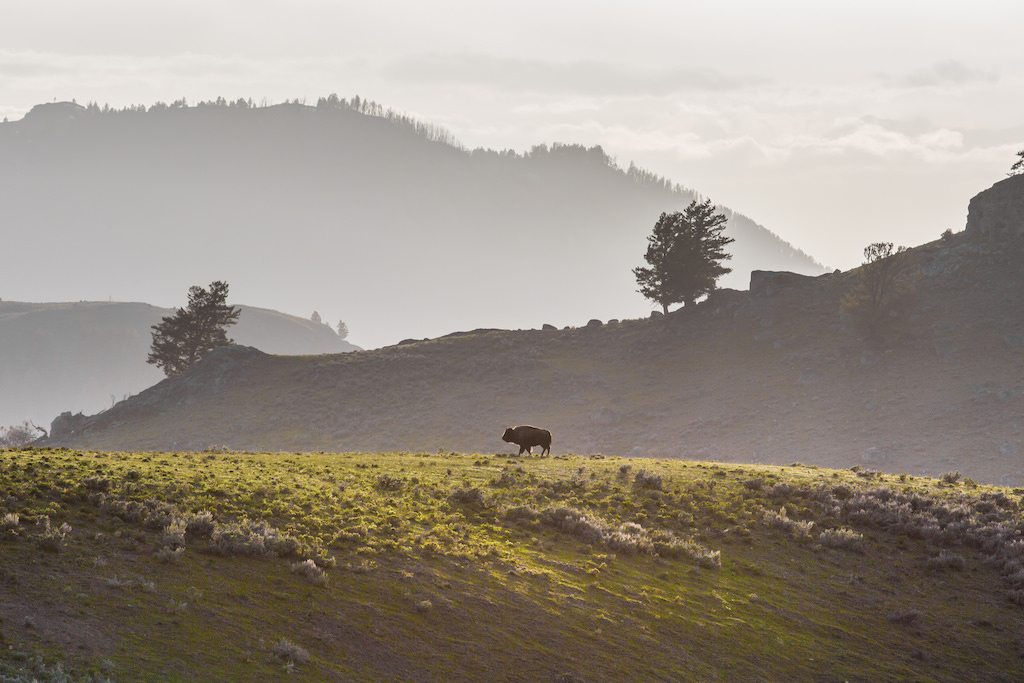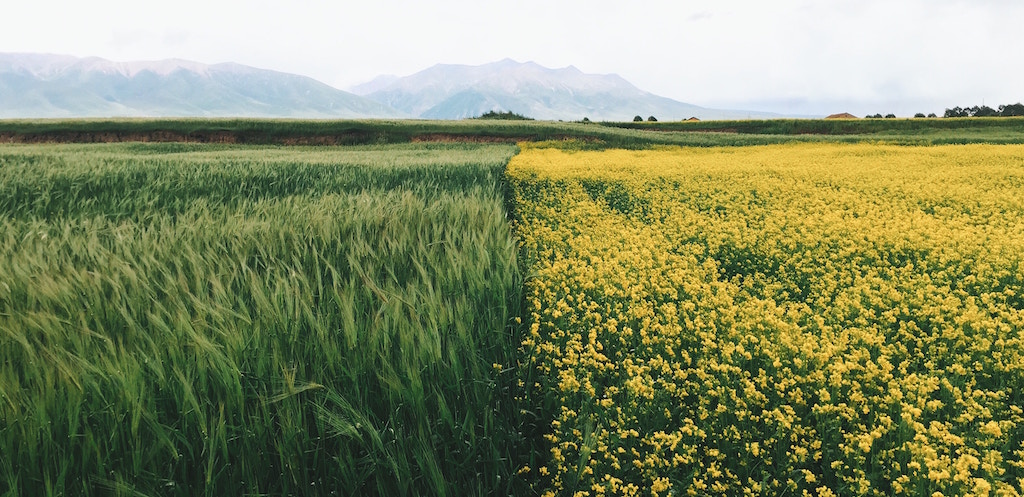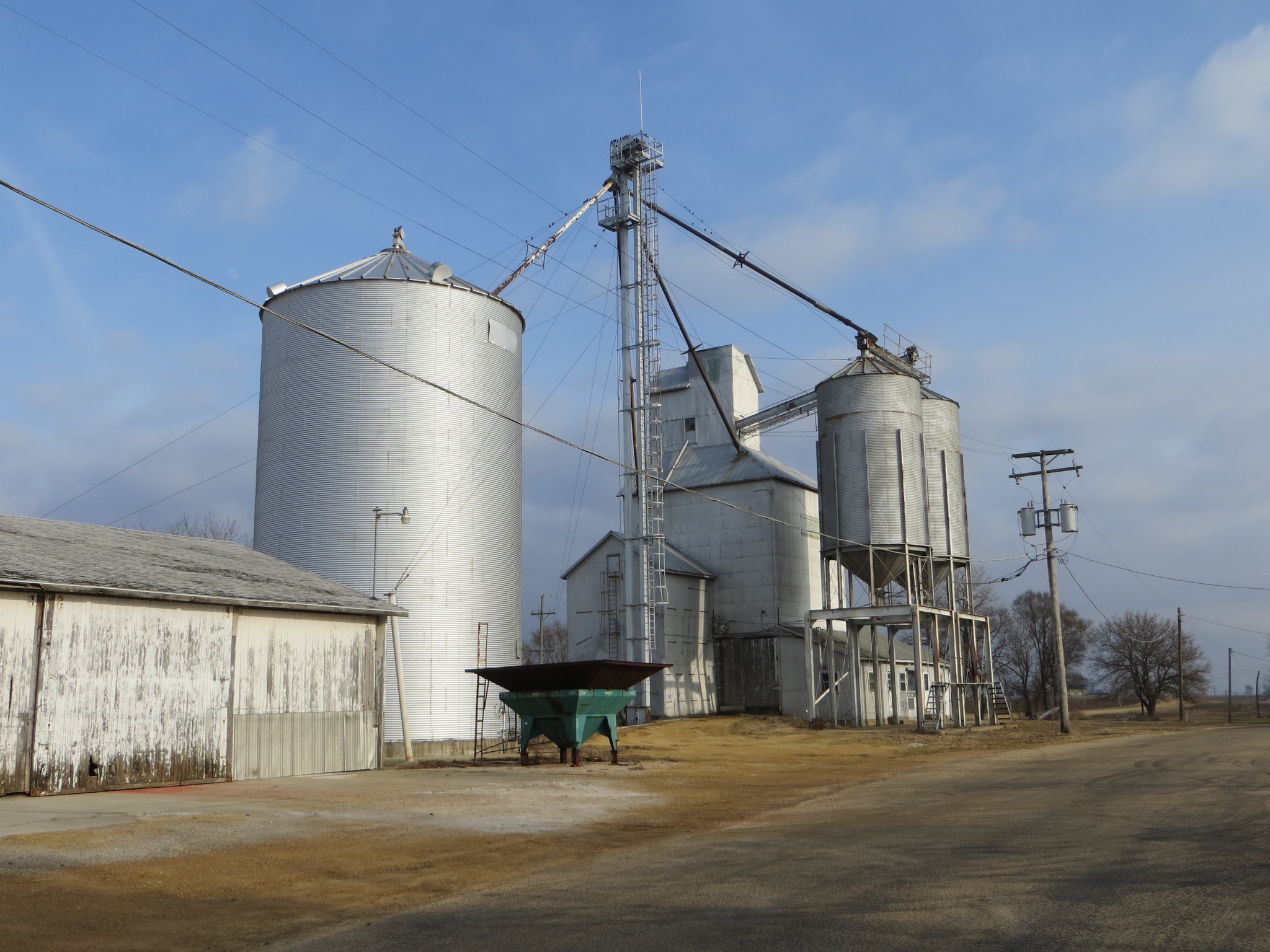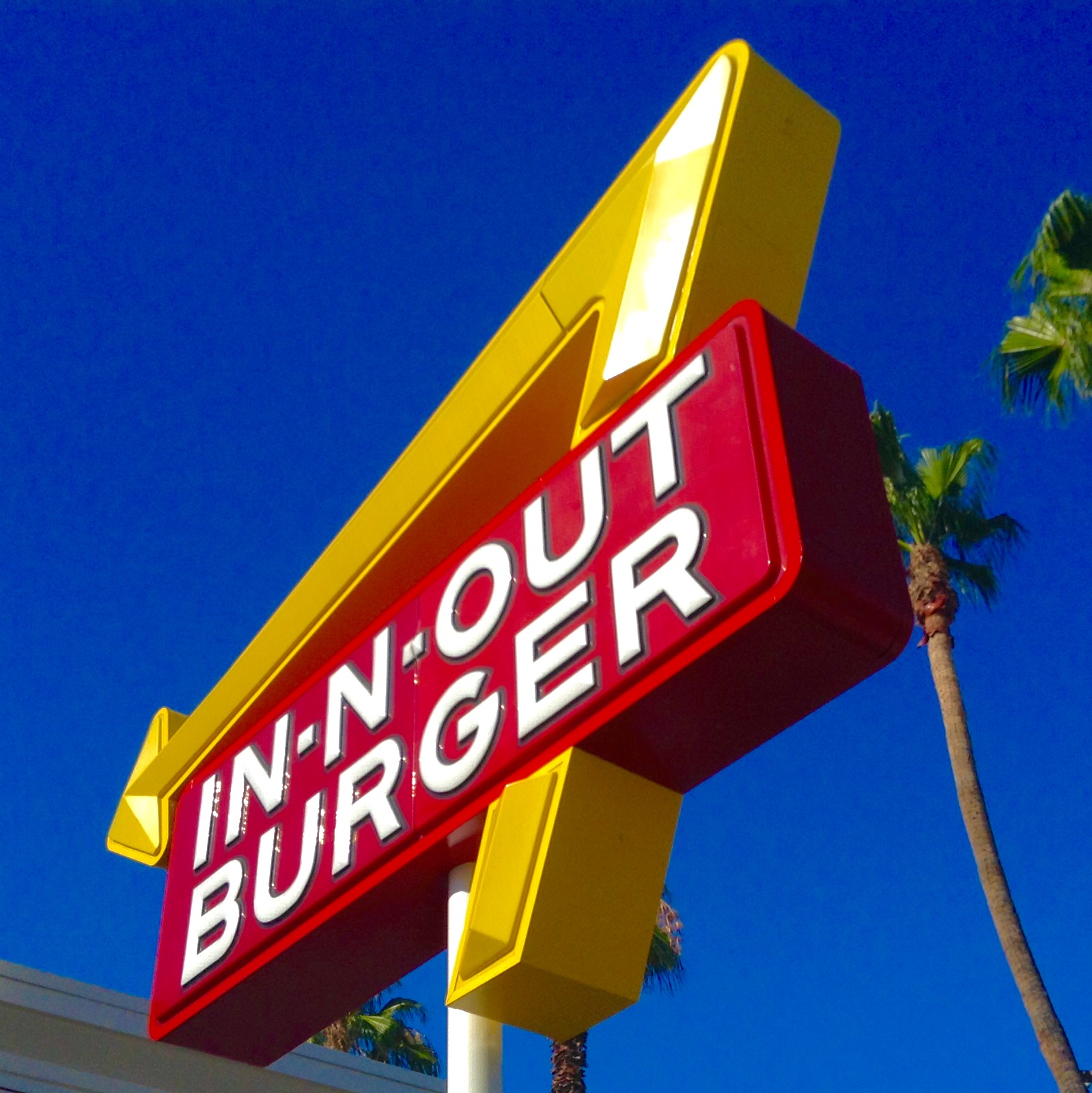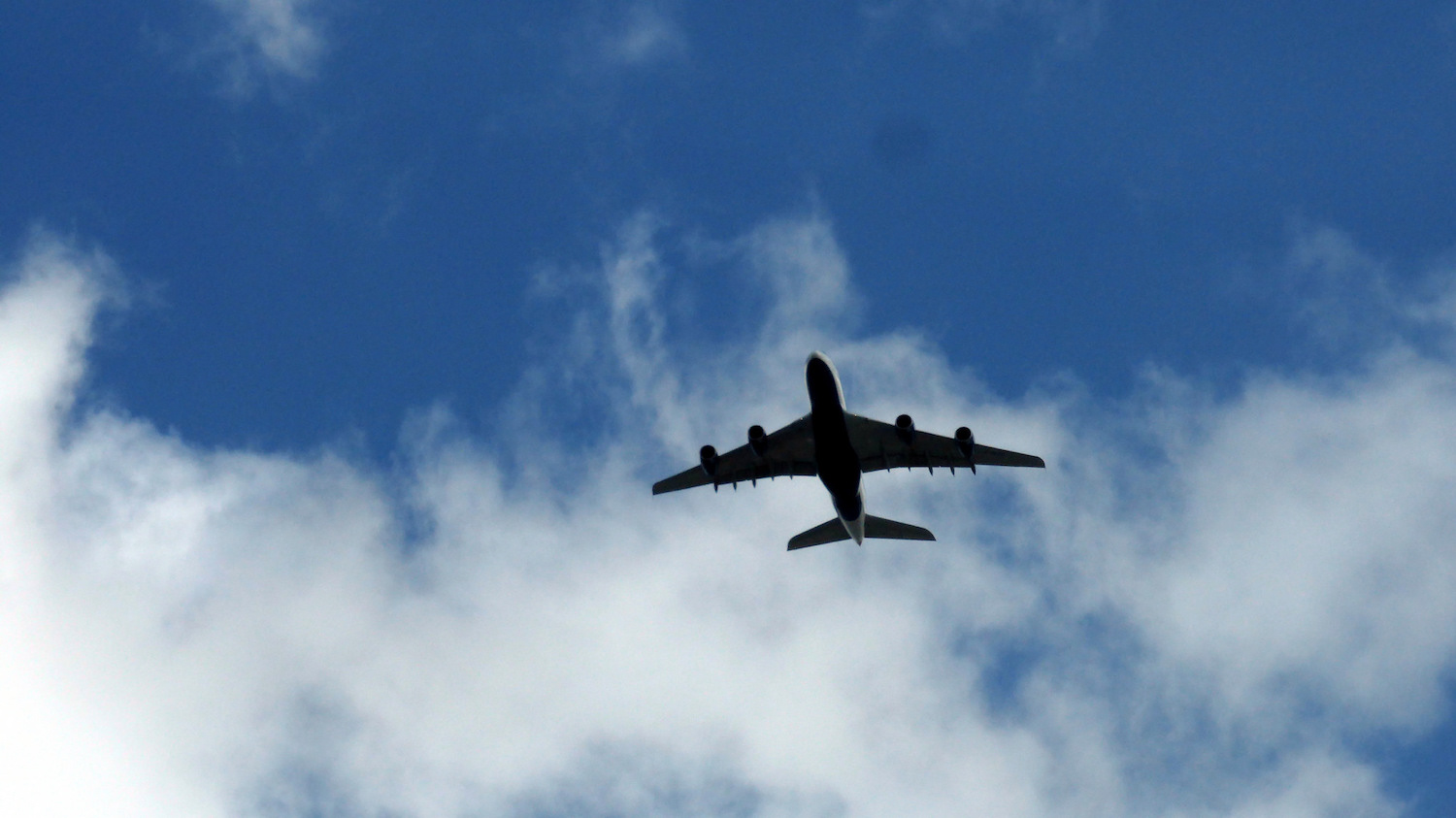By 1902, there were only 23 wild buffalo left in the United States. It was a dubious milestone that marked the rapid near-eradication of a species that had roamed the Great Plains by the tens of millions as recently as 1850, as it had for thousands of years before then. The 23 weren’t the country’s only buffalo—a few hundred remained on ranches, raised commercially for meat. Others lived in zoos. But they were last truly wild ones, genetically pure and never domesticated, and they lived in Yellowstone National Park.
The National Park Service’s (NPS) effort to bring Yellowstone’s wild buffalo back from the brink of near-extinction—from less than two dozen to a herd of several thousand today—is one of the nation’s great conservation successes. Which is what makes the agency’s current dilemma so strange: more recently, it’s been tasked with rounding up for slaughter the very animals it’s worked for more than a century to protect.
Earlier this year, NPS committed to thinning the herd by 900 to 1,300 Yellowstone buffalo, a reduction of up to 25 percent. The agency followed through: By the end of March, about 750 had been rounded up by park agents and given to local tribes for slaughter. (Another 453 were killed for food or for sport—by tribal hunters and other Montanans, as well by as tourists from out of state.) The total number of animals declined from about 5,500 to around 4,300 in three short months, the largest culling since 2008.
What could possibly warrant the mass killing of so many creatures, especially ones so few in number, with ancient genetics and singular behavioral traits? More than that: which are a key part of the American cultural mythos, were recently designated the country’s first national mammal, and which neighboring tribal populations consider not only culturally central but sacred?
It starts with a tiny bacteria, Brucella abortus, which causes a nasty disease called brucellosis. Yellowstone, in addition to being one of the last homelands to the buffalo, is also the country’s last reservoir of brucellosis, which causes spontaneous abortions in livestock and can be transmitted to humans during slaughter, or through raw milk. The disease isn’t much of a public health hazard in the U.S.—it’s been wiped from the nation’s cow herd by decades of aggressive management, including vaccination. All 50 states have been declared brucellosis-free by the United States Department of Agriculture (USDA). But that doesn’t mean there’s no brucellosis at all. It just means there’s no brucellosis in the cow industry. The buffalo of Yellowstone do carry brucellosis—about 50 to 70 percent of them are infected, according to Montana’s state brucellosis specialist, Eric Liska. And to many nearby farmers, they represent an unacceptable risk.
That’s why, since 2000, the Intra-Agency Bison Management Plan (IBMP) has required that Yellowstone’s bison population be capped at 3,000 animals. The agreement, which was brokered between five federal and state agencies—the NPS, USDA’s Forest Service, USDA’s Animal & Plant Health Inspection Service (APHIS), Montana’s Department of Livestock, and Montana’s Fish, Wildlife, & Parks department—is structured with two competing goals in mind: to allow NPS to maintain a healthy buffalo population inside the park, and to assure Montana’s farmers that their cattle herds will remain brucellosis-free.
That fraught boundary—where the success of a wild species is seen as detrimental to the well-being of a domesticated one—is where things get complicated. Especially considering another fact worth mentioning up front: there has never been a confirmed instance of bison spreading brucellosis to cattle. That’s not to say that buffalo can’t infect cows, the way several other wild species, like elk, are known to do. They certainly could, at least in theory. But a buffalo-to-cow transmission has never been documented—not in the past century, not ever.

Buffalo inside Yellowstone’s Stephens Creek Trap
During the winter, when temperatures are low and food is scarce, Yellowstone bison migrate north from Wyoming into the lower-elevation grasslands of Montana’s Gardiner Basin. Thanks to a 2015 decision by Montana’s governor, Steven Bullock, the animals are now allowed year-round residence in “tolerance zones” north and west of Yellowstone, about 400 square miles of extra grazing space outside the park. Their numbers will be kept in check by the local Indian tribes, who are allowed to hunt them. But buffalo attempting to leave the permitted areas will likely be “hazed” back in—herded by NPS agents on ATVs, SUVs, even helicopters.
The softened boundary doesn’t affect the slaughter. The wild buffalo population reproduces at a rate of 10 to 17 percent per year, about 10 times more quickly than humans do, and when they grow too numerous NPS agents on horseback will herd them into the Stephens Creek trap: a massive network of gated corral pens, big enough to hold hundreds of buffalo. Some will be released back into the wild as the weather warms. But others will be picked up by representatives of the InterTribal Buffalo Council, a group that includes the Nez Perce, Confederated Salish, and Kootenai tribes among its members. Those animals are hauled to the slaughter plant; the Council shares the resulting meat, hides, and skulls with its communities.
In any case, few animals make it outside the park and the surrounding borderlands. And that’s just the way Montana wants it.
The rationale usually cited for this vigilance is brucellosis, which can spell financial calamity for farmers and ranchers.
“It would be devastating. It could put you out of business,” says Gilles Stockton, director of the Montana Cattleman’s Association’s central district. “First of all, your ranch is quarantined. Your herd is quarantined. Yours and all of your neighbors’ cattle are taken in by the veterinarians and blood is drawn from all of them. They’re all tested to see if they have the disease. Any that are positive are immediately disposed of or sold. You’re still quarantined, and you’ve got to do it again, I don’t know how many times, until it’s proven that the remaining animals don’t have brucellosis. It takes a number of months to get yourself cleared to go back into normal production.”
The testing is expensive, and though the federal government subsidizes a portion of the cost, farmers aren’t paid for the extra time and hassle of having to stop production and inspect their entire herd. Perhaps worse, though, is the way infected animals are downgraded—cows that could be sold for a premium as breeding stock must instead be sold for cheap meat.
“Say you have a prime breeding cow in the prime of her life,” Stockton says. “You’ve spent a lifetime developing the genetics in that cow. She has a high monetary value, plus an emotional value because you get invested in it. Well, if she has brucellosis, she’s no longer a prime breeding cow. She’s a slaughter cow, a hamburger cow, which has one-third of the value.”
It’s more than just the individual producer’s bottom line. If two farms test positive within 12 months, the entire state can lose its brucellosis-free designation—which could have major economic consequences. States without the designation must have all their animals inspected at the state line, which makes interstate commerce more arduous and expensive—as much as $10 per head—and which hurts the desirability of the state’s product, though it goes beyond that. When a state loses brucellosis-free status, beef prices and exports across the country suffer. Every new outbreak is a setback that costs money.
“As far as international trade is concerned, the U.S. is restricted because we’re not brucellosis-free without vaccination,” Liska says. “So you have a country like Canada that is brucellosis-free without vaccination, and that opens doors for trade—you’re talking about billions of dollars. It’s a big issue locally, but even bigger issue internationally.”
It’s undeniable that brucellosis is a human health risk, and a serious economic liability for farmers, who have every right to try to protect their animals and their incomes. Still, there’s evidence that buffalo are a problem more in theory than in practice. New research suggests what pro-buffalo activists have long alleged—namely, that buffalo are a patsy of sorts. These advocates argue that bison have long taken the blame for another form of wildlife that also lives in Yellowstone and also carries brucellosis: Elk.
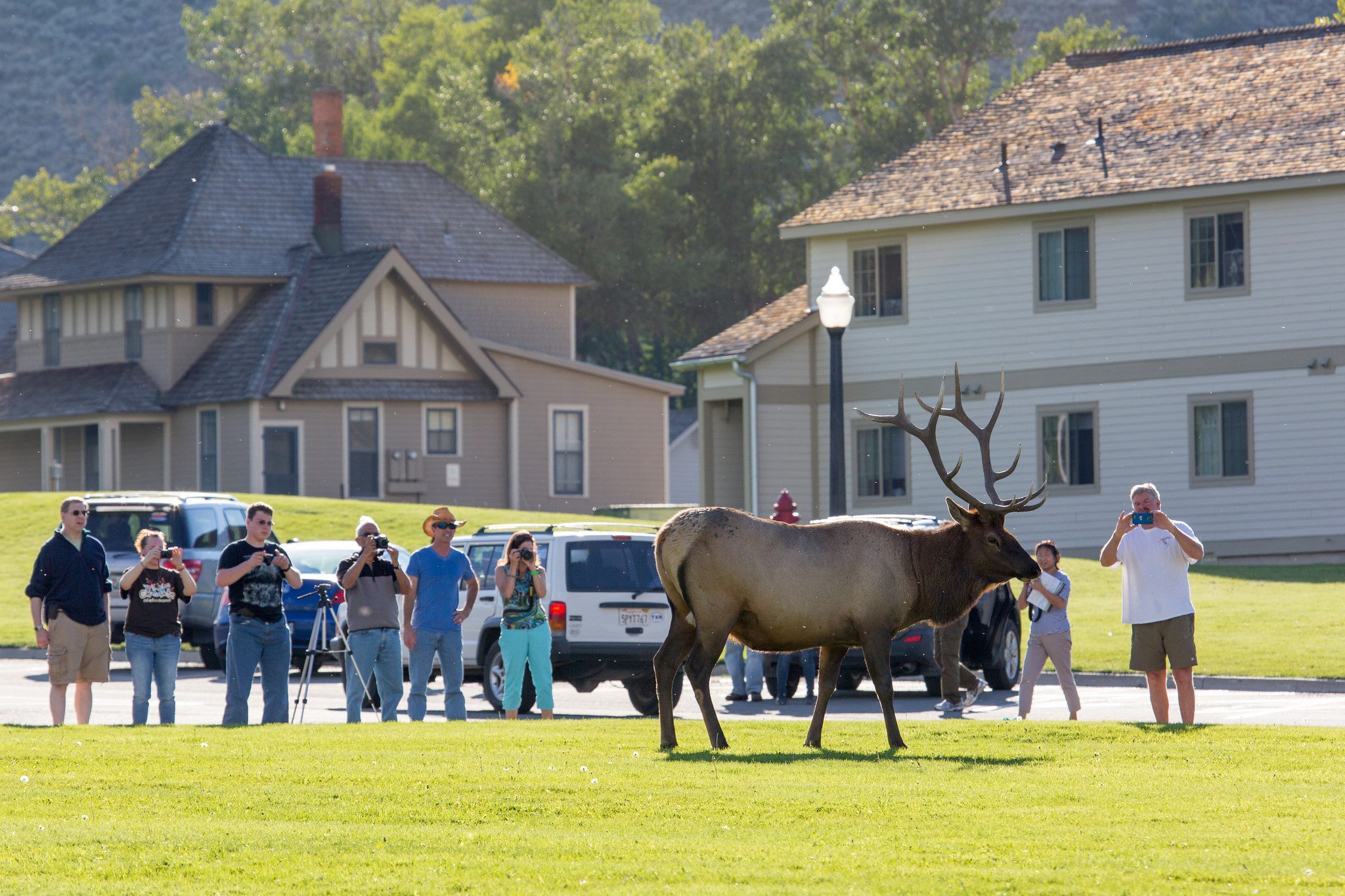
Unlike bison, Yellowstone’s elk are allowed to roam freely—and there are a lot of them
There are 125,000 elk in Yellowstone, and they’re also a success story. In 1900, only 50,000 elk remained in the entire country. Thanks to Yellowstone’s National Elk Refuge, and a series of feeding grounds throughout the park, the region’s population is thriving. Elk, unlike buffalo, have always been allowed to roam freely in and out of the park. But recently, they’ve started to get more attention as a vector of disease: it turns out that elk are infecting cattle with brucellosis, not buffalo.
Last year, 16 scientists co-authored a landmark study, published in the journal Nature Communications, that looked at Brucella abortus isolates gathered from animals over the course of almost 30 years. Yellowstone’s buffalo, the study found, have virtually no contact with cattle; their predictive model found zero cases of transmission. But elk do come into contact with cows—and they infect them.
The findings are, in part, a testament to the success of the IBMP—by keeping the buffalo inside of Yellowstone as much as possible, they rarely come into contact with commercial cow herds. But elk can’t be managed so easily. They leave the park freely, and when they do, they’re going to get mixed up with cattle.
“Their sheer number, and the way they move, and the fact that they can jump over fences with relative ease, makes them very difficult to herd or to move away from cattle,” Liska says. “And they move at night, very easily. So do bison, of course. But because of the ability of elk to move into pastures, and jump fences, it makes it very difficult to keep elk and cattle separate.”
Not that buffalo are completely off the hook. Since the study found that buffalo do infect elk, it’s possible that they play a supporting role in the spread of the disease to livestock: A buffalo could infect an elk, which could in turn infect a cow. But the study also found that brucellosis spreads quickly between elk, and much faster in the elk population than it does among buffalo. Elk, in other words, are incubating the disease quite well without help.
Furthermore, the study’s authors write that buffalo and elk aren’t “sympatric,” or don’t mingle, in the wild. Transmission may happen inside Yellowstone, but probably only because the species are kept in artificially close quarters. As the study’s authors put it: “Any possible role for bison as a reservoir [of brucellosis] may only be relevant at small geographic scales.” Confining bison inside the park lowers the risk that they’ll spread brucellosis to cows directly—but, ironically, that very policy may increase the risk that they’ll infect elk, who spread the disease outside the park.
More importantly: If elk are just as likely, if not more, to pass along brucellosis, why are buffalo the ones being barricaded inside Yellowstone? Isn’t that a double standard?
I posed this question to Rick Wallen, who has been Yellowstone’s head bison biologist since 2002, and has helped implement the park’s end of the IBMP agreement almost since the beginning. (Wallen also co-authored the Nature Communications study.)
“I think we’ve dispelled the rumor that if we could simply eliminate brucellosis in wild bison it would automatically go away in elk. That’s simply not the case,” he says. “But that idea was a founding principle in the development of our inter-agency plan all those years ago. We probably need to reassess whether the state could be more tolerant [of bison]—because they’re tolerant of wild elk, yet wild elk have a greater risk of transmission to cattle than bison do.”
So what’s keeping Montana from softening its position and allowing even more wild buffalo into the state? Part of it could be inertia. There’s always lag time before the latest research is reflected in policy. Or it could be a culture of zero tolerance among the state’s politically powerful ranchers, who would rather see bison slaughtered than incur any added risk.
But the more I spoke with Wallen and others, the more it became clear: in some ways, the IBMP agreement is not about brucellosis at all, even though brucellosis is its stated rationale for slaughter.
It’s about who gets to eat the grass.
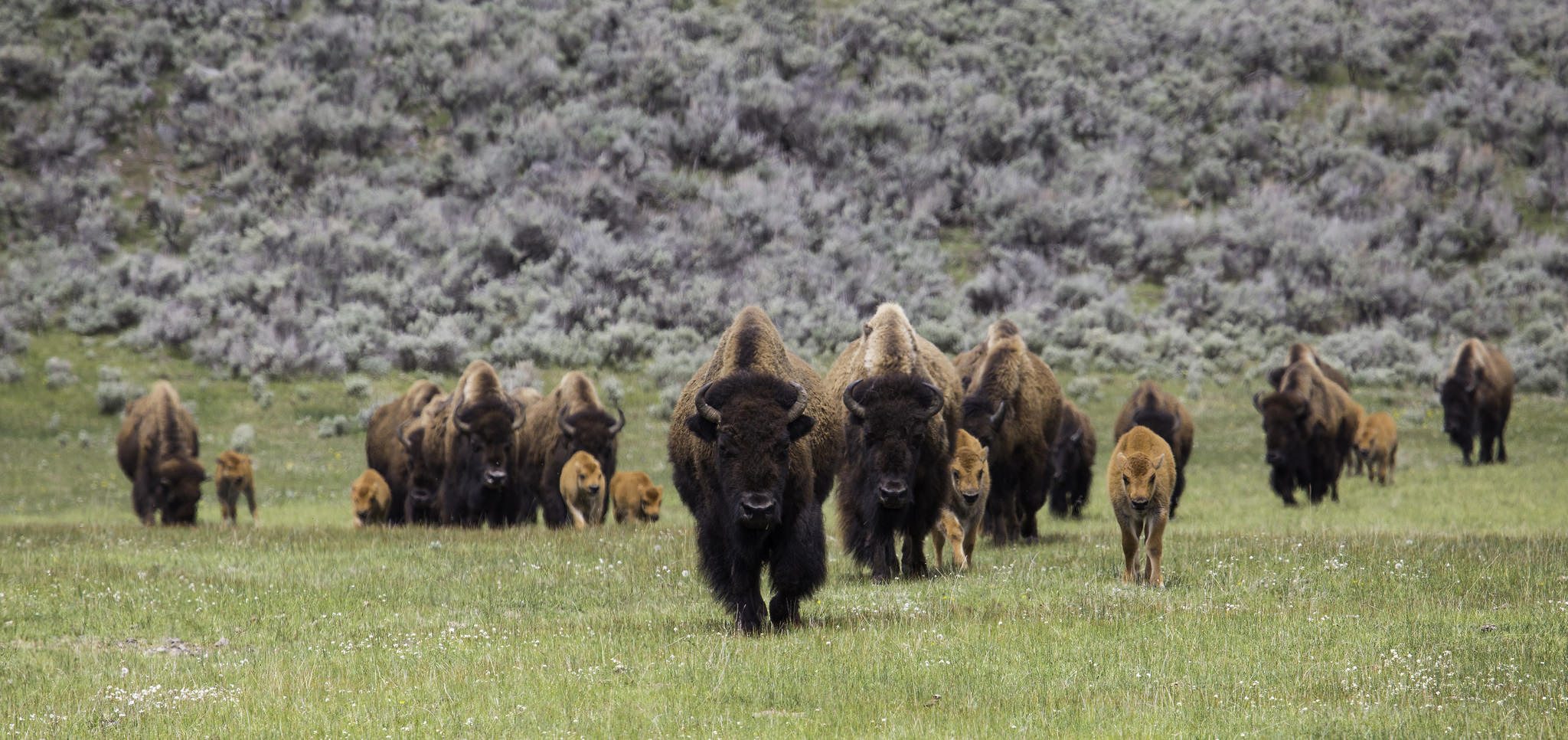
Buffalo and their calves in Yellowstone National Park
I first heard the accusation that brucellosis is a cover for concerns about grazing and land use from Stephany Seay, a volunteer with the Buffalo Field Campaign (BFC), whose volunteers embed with Yellowstone’s roving buffalo the way journalists will with platoons in a combat zone.
“We run daily field patrols with the buffalo every day, all day long, sometimes into the night. Standing with them on the ground they choose to stand on,” she says. “And when the governments or hunters come to harm them, we are there to document and share our footage and stories and experiences with the media, with the public, with decision makers. And we fight for the buffalo on the ground, in the courts, in the policy arena.”
From Seay’s perspective, the quota of buffalo is far less than what the park can sustain, and the aggressive push to cull the herd suits the cattle industry.
“Ultimately, this is a range war, this is a centuries old range war,” she says. “Bison are the native bovine of this country, of this continent, and the cattle industry views them as competitors for grass. They’re worried about the buffalo migrating into Montana, which is their nature—they’re a migratory species. But the industry doesn’t want them eating Montana grass. The more you look at this issue the less it becomes about this smoke screen brucellosis.”
If the disease were really a cover of some kind, you’d think that representatives of the cattle industry would be cagey on the topic of bison grazing. But I was surprised to find that, when I asked Stockton what his primary concern would be if the buffalo were allowed to leave Yellowstone, he started talking about grass.
“I think the most immediate aspect of it is the property rights thing,” he says. “A buffalo is a big animal and it consumes a lot of grass. The land that the buffalo would be invading is owned by somebody, and they’re managing it for purposes other than buffalo.”
“It’s like anybody,” he goes on. “I’m sure your wife doesn’t like mice in her kitchen cabinets. Or the war against moles in people’s lawns. One white-tailed deer in your backyard might be cute. But 20, that’s another story.”
Grass, of course, is a finite resource, and something of a zero-sum game: if buffalo were allowed to roam wild in Montana, it probably would mean less grass for cattle.
“Montana’s an arid place,” Stockton says. “You look at the valley floors and it could really be quite lush, but the minute you get up onto the hills and the rougher country, the amount of grass that’s being raised is much less. Roughly speaking, it’s about a half a ton per acre, per season. That’s a thousand pounds of grass that your hillside can produce, and a cow will eat 25 pounds of grass every day.”
He does some quick math out loud.
“So there’s 40 days’ worth of grass on an acre of ground. But you don’t want to graze it to the bare ground. You want to leave half of that, because otherwise you start harming the roots of the plants. So you’ve got 20 days’ worth of grazing per acre. A cow can eat that, an elk can eat that, or a buffalo can eat that. But once it’s eaten, it’s gone.”
Apparently, there’s a well-known dollar figure attached to grass in Montana: people renting pasture charge an additional $30 monthly per animal to cover the cost of the grass. According to Stockton, that means buffalo outside the park on private land are eating $30 a month of a resource that’s not theirs—which would add up quickly when you’re talking six warm months, and thousands of buffalo.
I asked Stockton if his grass, not brucellosis, was his primary concern about buffalo.
“The brucellosis is priority number one,” he says. “For me, I’m 200 miles from the park. If I was 2 miles from the park, that would be a different calculation.”
In other words, Stockton, like most of Montana’s ranchers don’t have to worry about buffalo; they’re not roaming wild in most of the state. But if they started to be allowed to, the priorities would start to shift quickly.
The Montana Department of Livestock, for its part, denies this.
“There are numerous factors that limit the range of Yellowstone National Park bison in Montana,” the department told me, in an emailed statement. “However, the threat of diseases transmission, and the continued ability for the state to participate in interstate commerce of cattle and domestic bison remains a priority in Montana. The chief concern is ensuring our actions help us maintain brucellosis free status with federal authorities and don’t give reason for neighboring state animal health officials to take restrictive action against import of livestock from Montana.”
I asked Wallen if he thought the brucellosis argument was, in part, a cover for concerns about Montana’s grass.
“There are people who would rather see cattle on the landscape than bison because that’s what they prefer,” he says. “The bottom line is, I have to assume they prefer that because [bison] compete directly for space and grass. The farmers and ranchers that I talk to say, ‘Look, we already put up with all of these other species of herbivores. They already eat the grass that we grow on our private property. We don’t want to take on any additional wildlife eating that grass that we would like to grow for our livestock, for our livelihood.’”
Stockton would probably agree with that characterization. But everyone has a price, he says—the state could probably pay some ranchers to let them allow wild buffalo on private land.
“Then, instead of having the grass resources for 3,500 buffalo you’ve got grass resources for 5,000 buffalo,” he says. “But what happens when the herd increases to 6,000 buffalo? Do you rent more winter pasture to them? When is enough buffalo enough?”
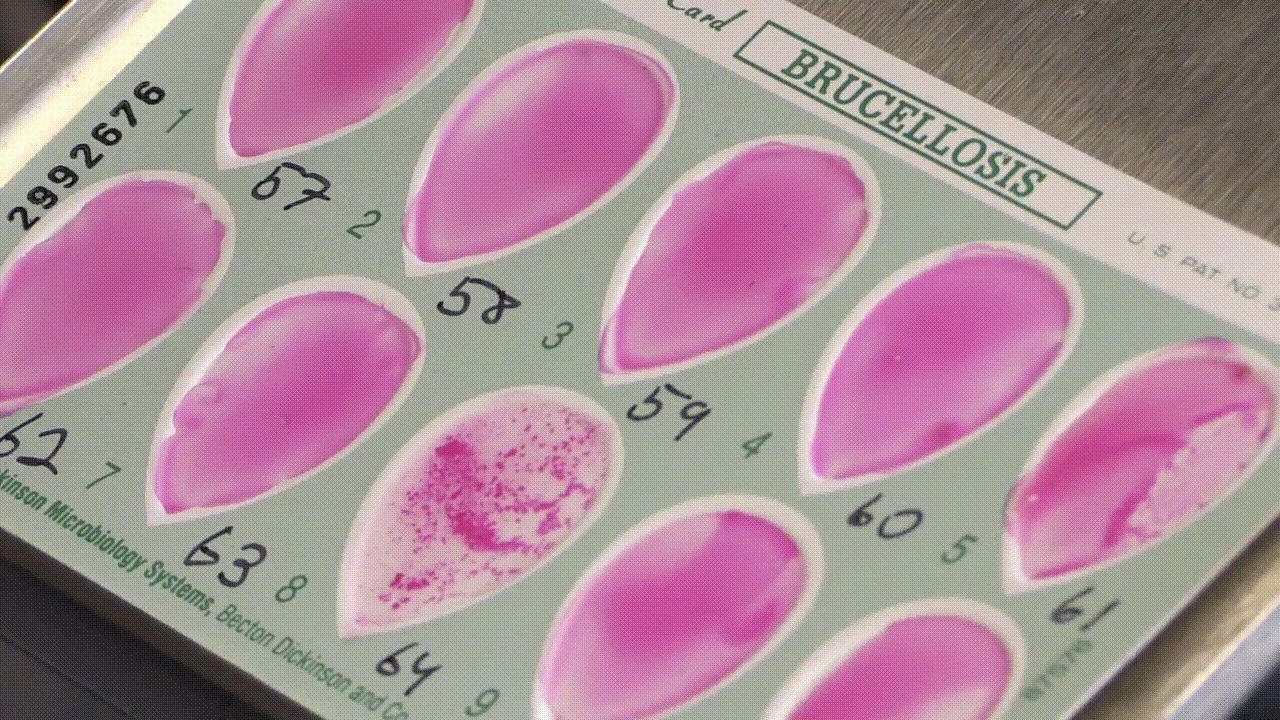
A brucellosis test used on bison at the Stephens Creek trap
In 2015, the state of Montana and Yellowstone National Park announced they were working to rewrite the IBMP. The newly drafted plan was supposed to be published in 2016, but efforts are apparently on hold.
“The short version of the answer is it’s not going smoothly,” Wallen told the Bozeman Daily Chronicle in March. “It’s pretty much on hold.”
Representatives from the Montana Department of Livestock told me the process was “ongoing,” but declined to be more specific.
At this point, you can probably guess what the bones of contention are. The NPS wants a more tolerant attitude towards bison, one that allows them to migrate more freely into Montana. And the cattle industry wants a plan that ramps up the fight against brucellosis, prioritizing confinement and preventative research.
Talks are supposed to resume this spring, but they may not go very far. The issue boils down to an essential conflict in the American character, an ongoing negotiation over how much wildness is desirable, and how much nature to permit on land we use. Sometimes, this looks like fighting between farmers and conservationists, but it’s also a divide that splits agriculture itself. There are farmers who feel crops and animals should be grown in relative accordance with nature, harnessing its power. And there are those who farm in manmade environments they control completely, endlessly working to fence production away from the complexity of the outside world.
Buffalo, you could even argue, were collateral damage in a war between ideologies. Their near-annihilation, centuries ago, was a statement about what the North American landscape should look like. And though this slaughter was explicitly an attack on native cultural heritage, it was also a targeted destruction of an ample wild food source—a violent insistence that food should be grown and harvested on private property, not foraged directly from shared earth. With the buffalo gone, that argument got easier to make.
In our contemporary version of this battle, there’s some hope that the two sides—farmer and conservationist—can find common ground. The first is a scientific solution: it may be possible to vaccinate the buffalo, and hopefully eradicate brucellosis in them over time. There have been efforts to create a buffalo vaccine, like the one that currently works for cattle, but research has been slowed due to a regulatory quirk. Since Brucella is listed as a Class B bio-terrorism agent, access to it for research purposes is tightly controlled. Even if there were market forces driving the development of a vaccine for Yellowstone bison, this would still be slow going.
And assuming a vaccine could be developed, there would still be logistical issues. It’s no small task to vaccinate a herd of thousands of wild creatures and monitor them to be sure they’re brucellosis-free. Who would do the work, and who would be responsible for paying for it? Beyond that, would Americans who want to see the buffalo roam freely find widespread vaccination unpalatable?
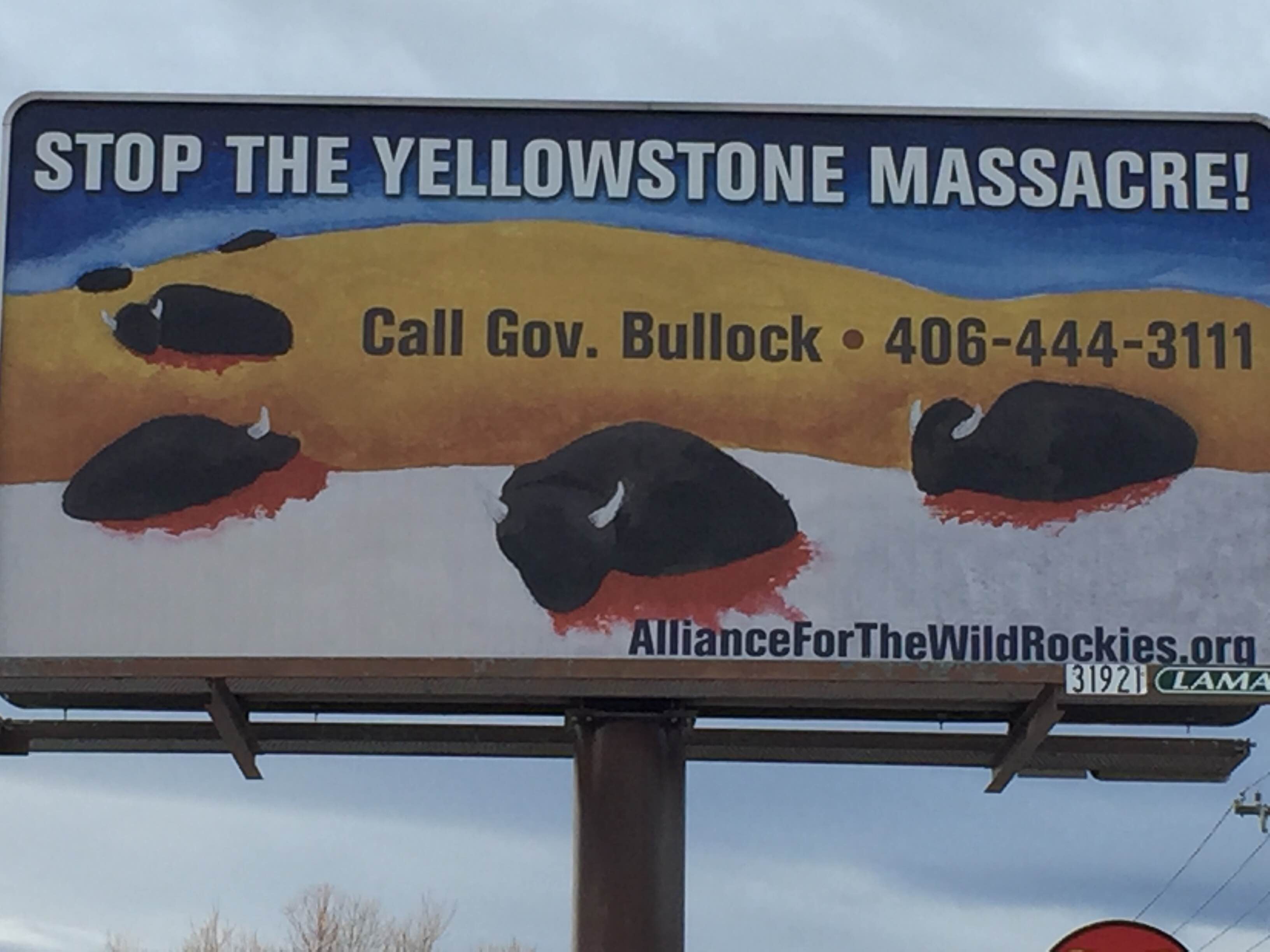
A Montana billboard by artist Steve Kelly
Mike Garrity
“A lot of people—including, I believe, the Park—really don’t want to see Yellowstone bison treated like cattle, or like some kind of livestock run through a chute,” Liska says. “You’d really have to work with these animals to test them and vaccinate them. But would the public accept that? That’s the question. It’s a hurdle, and an obstacle.”
He’s got a point. The more you micro-manage an animal for any reason, the tamer it becomes. And at some point, even if it has no owner, a wild bison is no longer wild.
Another option is to see wild buffalo as an economic resource, and let them run wild for the financial good of the state. This is the approach some researchers have already suggested is the best way to handle feral swine, another form of wildlife that has met with great antagonism from farmers, agribusiness, and private property owners. (In Texas, they kill them with virulent poisons and gun them down from helicopters.) Yes, feral swine cause property damage. But a 2013 study from Texas A & M found that the economic value of feral swine actually outweighed the negative impacts, thanks to subsistence hunting and increased tourism for sport hunters.
A similar approach could be taken with wild buffalo. Yes, some farmers would probably want to build new fences (a buffalo can jump six feet from a standstill). But there would be added benefits to having them on the landscape, including opportunities for farmers to lease land to the state, and money brought in through hunting permits and tourism dollars.
Elk, in a way, are proof that this approach works. Recently, the state of Wyoming decided not to close the 22 elk feeding grounds it operates in and around Yellowstone, even though those areas help brucellosis spread more quickly. Why? A University of Wyoming study found that closing the feeding grounds would reduce the elk population by 70–80 percent, which in turn would take an estimated $22 million a year out of the state. It was just too much money to pass up.
Ultimately, Wallen says, if the buffalo are going to thrive, they’ll have to be allowed to migrate outside the park. And that’s another way people can make a difference, if they want more buffalo: by letting officials know they’re willing to tolerate the risks.
“That is a value-based question that society needs to answer,” he says. “All wildlife in the United States are public resources. The public needs to weigh in and make sure the leaders in the state of Montana can protect that public resource for the greatest good, for the greatest number of public values. If we want wild bison in modern society, we just need to figure out who and what and how and where. We have the agency expertise at the both the state and federal levels to make all of that happen.”
Letting the buffalo roam again would not be without downsides. The threat of transmitting brucellosis to other livestock probably could not be mitigated entirely. Car accidents would surely happen, the way they do with elk and deer. And a certain amount of private property owners would find themselves hosting some uninvited—if temporary—guests. Still, the question shouldn’t be whether allowing more wild buffalo would have any drawbacks. It should be whether the benefits outweigh the risks.
Just as I was hanging up the phone with Stockman, he seemed to remember something.
“You know, you should visit Yellowstone Park,” he said, suddenly animated. “It’s one of the most magnificent places in the world, really.”
I told him that I hoped to. He told me he’d done work in Africa and had seen wildebeests and zebras on the hills of the Maasai Mara. Still, there’s nothing like seeing a herd of buffalo in the wild.
“It’s something that should be on everyone’s bucket list,” he says. “I don’t how you’d describe it. But to be sharing the road with fifty buffalo walking alongside of you. It’s really something.”
